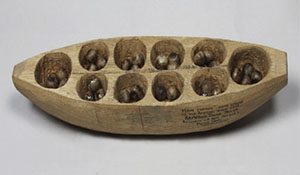
Mancala is one of the oldest two-player strategy games in the world and has been played throughout Asia and Africa for over 7.000 years. Earlier version of Mancala games used primitive tools constructed of wood or clay, or the game board were carved in stone.

It's origins are rooted in ancient Egypt. Stone Mancala boards from 1400BC have been found carved into the roofs of Kurna temples in Memphis, Thebes and Luxor. The game spread from Egypt to many parts of Africa and then to the Middle East. Proof was found in Palmyra in Syria.
In the agora of Izmir, a Mancala board was found which proofs that the Romans and ancient Greeks also played the game.
These versions of the game typically contain holes which house marbles or rocks, seeds or beans, or other small round objects called “seeds”. The number of seeds and the number of holes featured depends on the type of game.In certain West-African dialects the holes in the board are referred to as warri or awari and in those cultures the game is called "Wari".
Islamic cultures name the game with respect to the physical action that takes place during the game calling the game "mancala" (The word "mancala" means to move in Arabic).
Count-and-Capture Games were never very popular in Europe, except in the Baltic area, where they loved the game Bohnenspiel. But still mancala boards were found in ancient castles in Germany, Greece, Bosnia and Serbia.
Mancala is played today primarily in Africa, the Middle East, Asia and the Caribbean area. The USA has also a larger mancala playing population.
There are a number of commercial versions of the game. The first commercial version was published in the United States in 1891 by the Milton Bradley Company under the name of Chuba. A wooden version of the game was produced in the 1950s by the Kalah Game Company, Holbrook.
Continue Reading


